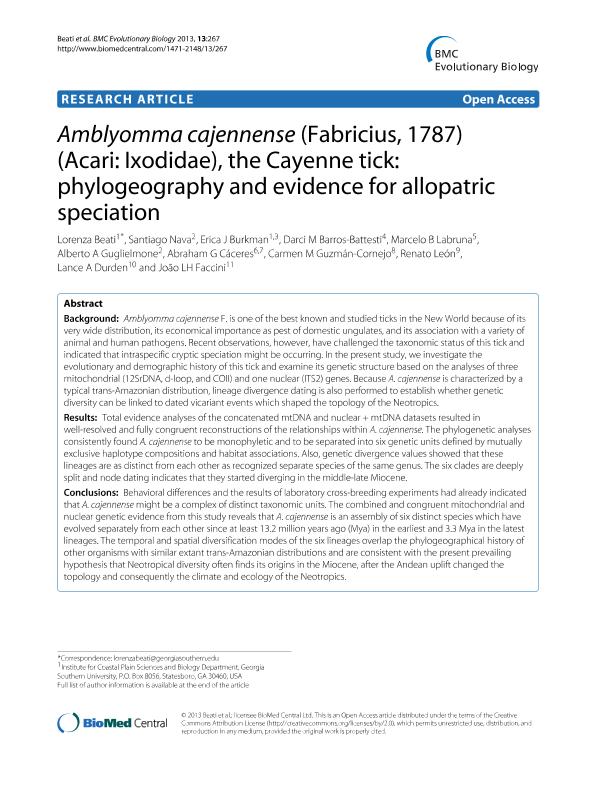Mostrar el registro sencillo del ítem
dc.contributor.author
Beati, Lorenza
dc.contributor.author
Nava, Santiago

dc.contributor.author
Burkman, Erica J.
dc.contributor.author
Barros Battesti, Darcy M.
dc.contributor.author
Labruna, Marcelo B.
dc.contributor.author
Guglielmone, Alberto Alejandro

dc.contributor.author
Cáceres, Abraham G.
dc.contributor.author
Guzman Cornejo, Carmen
dc.contributor.author
Léon, Renato
dc.contributor.author
Durden, Lance A.
dc.contributor.author
Faccini, João L.H.
dc.date.available
2015-08-26T19:37:00Z
dc.date.issued
2013-12
dc.identifier.citation
Beati, Lorenza; Nava, Santiago; Burkman, Erica J.; Barros Battesti, Darcy M.; Labruna, Marcelo B.; et al.; Amblyomma cajennense (Fabricius, 1787) (Acari: Ixodidae), the Cayenne tick: phylogeography and evidence for allopatric speciation; BioMed Central; BMC Evolutionary Biology; 13; 267; 12-2013; 1-20
dc.identifier.issn
1471-2148
dc.identifier.uri
http://hdl.handle.net/11336/1837
dc.description.abstract
Background: Amblyomma cajennense F. is one of the best known and studied ticks in the New World because of its very wide distribution, its economical importance as pest of domestic ungulates, and its association with a variety of animal and human pathogens. Recent observations, however, have challenged the taxonomic status of this tick and indicated that intraspecific cryptic speciation might be occurring. In the present study, we investigate the evolutionary and demographic history of this tick and examine its genetic structure based on the analyses of three mitochondrial (12SrDNA, d-loop, and COII) and one nuclear (ITS2) genes. Because A. cajennense is characterized by a typical trans-Amazonian distribution, lineage divergence dating is also performed to establish whether genetic diversity can be linked to dated vicariant events which shaped the topology of the Neotropics. Results: Total evidence analyses of the concatenated mtDNA and nuclear + mtDNA datasets resulted in well-resolved and fully congruent reconstructions of the relationships within A. cajennense. The phylogenetic analyses consistently found A. cajennense to be monophyletic and to be separated into six genetic units defined by mutually exclusive haplotype compositions and habitat associations. Also, genetic divergence values showed that these lineages are as distinct from each other as recognized separate species of the same genus. The six clades are deeply split and node dating indicates that they started diverging in the middle-late Miocene. Conclusions: Behavioral differences and the results of laboratory cross-breeding experiments had already indicated that A. cajennense might be a complex of distinct taxonomic units. The combined and congruent mitochondrial and nuclear genetic evidence from this study reveals that A. cajennense is an assembly of six distinct species which have evolved separately from each other since at least 13.2 million years ago (Mya) in the earliest and 3.3 Mya in the latest lineages. The temporal and spatial diversification modes of the six lineages overlap the phylogeographical history of other organisms with similar extant trans-Amazonian distributions and are consistent with the present prevailing hypothesis that Neotropical diversity often finds its origins in the Miocene, after the Andean uplift changed the topology and consequently the climate and ecology of the Neotropics.
dc.format
application/pdf
dc.language.iso
eng
dc.publisher
BioMed Central

dc.rights
info:eu-repo/semantics/openAccess
dc.rights.uri
https://creativecommons.org/licenses/by-nc-sa/2.5/ar/
dc.source
BioMed Central
dc.subject
Amblyomma Cajennense
dc.subject
Phylogeography
dc.subject
Allopatric Speciation
dc.subject.classification
Genética y Herencia

dc.subject.classification
Ciencias Biológicas

dc.subject.classification
CIENCIAS NATURALES Y EXACTAS

dc.subject.classification
Ciencias Veterinarias

dc.subject.classification
Ciencias Veterinarias

dc.subject.classification
CIENCIAS AGRÍCOLAS

dc.title
Amblyomma cajennense (Fabricius, 1787) (Acari: Ixodidae), the Cayenne tick: phylogeography and evidence for allopatric speciation
dc.type
info:eu-repo/semantics/article
dc.type
info:ar-repo/semantics/artículo
dc.type
info:eu-repo/semantics/publishedVersion
dc.date.updated
2016-03-30 10:35:44.97925-03
dc.journal.volume
13
dc.journal.number
267
dc.journal.pagination
1-20
dc.journal.pais
Reino Unido

dc.journal.ciudad
Londres
dc.description.fil
Fil: Beati, Lorenza. Georgia State University; Estados Unidos
dc.description.fil
Fil: Nava, Santiago. Instituto Nacional de Tecnología Agropecuaria. Centro Regional Santa Fe. Estación Experimental Agropecuaria, Rafaela; Argentina. Consejo Nacional de Investigaciones Científicas y Técnicas. Centro Científico Tecnológico Conicet - Santa Fe; Argentina
dc.description.fil
Fil: Burkman, Erica J.. Georgia State University; Estados Unidos
dc.description.fil
Fil: Barros Battesti, Darcy M.. Governo Do Estado de Sao Paulo. Secretaria Da Saude. Instituto Butantan; Brasil;
dc.description.fil
Fil: Labruna, Marcelo B.. Universidade do Sao Paulo; Brasil;
dc.description.fil
Fil: Guglielmone, Alberto Alejandro. Instituto Nacional de Tecnología Agropecuaria. Centro Regional Santa Fe. Estación Experimental Agropecuaria, Rafaela; Argentina. Consejo Nacional de Investigaciones Científicas y Técnicas. Centro Científico Tecnológico Conicet - Santa Fe; Argentina
dc.description.fil
Fil: Cáceres, Abraham G.. Instituto Nacional de Salud; Perú
dc.description.fil
Fil: Guzman Cornejo, Carmen. Universidad Nacional Autónoma de México; México;
dc.description.fil
Fil: Léon, Renato. Universidad San Francisco de Quito; Ecuador;
dc.description.fil
Fil: Durden, Lance A.. Georgia State University; Estados Unidos
dc.description.fil
Fil: Faccini, João L.H.. Universidade Federal Rural Do Rio de Janeiro; Brasil
dc.journal.title
BMC Evolutionary Biology

dc.relation.alternativeid
info:eu-repo/semantics/altIdentifier/url/http://www.biomedcentral.com/1471-2148/13/267
dc.relation.alternativeid
info:eu-repo/semantics/altIdentifier/doi/http://dx.doi.org/10.1186/1471-2148-13-267
Archivos asociados
